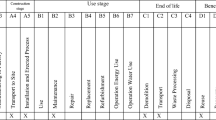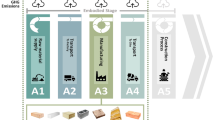Abstract
The effects on the external environment of seven concrete and steel building frames representative of present-day building technology in Sweden were analysed using LCA methodology. Objects of the study included frame construction and supplementary materials. Several-storey offices and dwellings were studied. The functional unit was defined as one average m2 of floor area during the lifetime of the building. Inventory data were elaborated for concrete and steel production, the building site, service life, demolition and final disposal. Parameters included were raw material use, energy use, emissions to air, emissions to water and waste generation. The inventory results were presented and evaluated as such, in addition to an interpretation by using three quantitative impact assessment methods. Parameters that weighed heavily were use of fossil fuels, CO2, electricity, SOx 2 NOx 2 alloy materials and waste, depending on what assessment method was used. Over the life cycle, building production from cradle to gate accounted for about the same contribution to total environmental loads as maintenance and replacement of heat losses through external walls during service life, whereas demolition and final disposal accounted for a considerably lower contribution.
Similar content being viewed by others
References
Björklund T, Jönsson Å, Tillman A-M.: LCA of Building Frame Structures. Environmental Impact over the Life Cycle of Concrete and Steel Frames. Report 1996:8, Technical Environmental Planning, CTH (Chalmers University of Technology), Göteborg, 1996
Amato A, Eaton K J.: A comparative life-cycle assessment of steel and concrete framed office buildings. Proceedings of Second International Conference on Building and the Environment, CIB TG8, June 9–12, Paris, 1997
Life-Cycle Energy Use in Office Buildings. The Environmental Research Group, School of Architecture, UBC (University of British Columbia), Forintek Canada Corp., Vancouver, 1994
Petersen EH.: Livscyklusvurderingaf bygningsdele. SBI report 272, SBI (Statens Byggeforskningsinstitut), Hoersholm, 1997
Erlandsson M.: Environmental Assessment of Building Components. Licentiate of Engineering Thesis, TRITA-BYMA 1995:1, KTH (Royal Institute of Technology), Stockholm, 1995
ISO 14040. Environmental management - Life cycle assessment -Principles and framework. First edition, TC 207/SC 5, 1997
Consoli F (ed.) et al.: Guidelines for Life-Cycle Assessment: A ‘Code of Practice’. SETAC (Society of Environmental Toxicology and Chemistry), Brussels/Pensacola, 1993
Heijungs R (ed.) et al.: Environmental life cycle assessment of products - Backgrounds and Environmental life cycle assessment of products — Guide, CML, TNO, B & G, Leiden, 1992
Life-Cycle Assessment: Inventory Guidelines and Principles. EPA/600/R-92/036, EPA (Environmental Protection Agency), Cincinnati, 1992
Lindfors L-G et al.: Nordic Guidelines on Life-Cycle Assessment. Nord 1995:20, Nordic Council of Ministers, Copenhagen, 1995
Steen B, Ryding S-O.: The EPS Enviro-Accounting Method. An application of environmental accounting principles for evaluation and valuation of environmental impact in product design. IVL report B 1080, IVL (Swedish Environmental Research Institute), Goteborg, 1992
Miljömässiga skillnader mellan återvinning/återanvändning och förbränning/deponering. CTH, CIT, IVL, SI. Reforsk FoU nr 79, 1993
Ahbe S,Braunschweig A,Muller-Wenk R.: Methodik für Oekobilanzen auf der Basis ökologischer Optimierung. Schriftenreihe Umwelt nr 133, BUWAL, Bern, 1990
Wermelin I.: Aktiv kostnadskalkylering med hjälp av BSAB-systemet. AB Svensk Byggtjänst, Stockholm, 1983
Tillman A-M et al.: Packaging and the Environment. SOU 1991:77, Allmänna förlaget, Stockholm, 1991
Boustead I.: Eco-balance methodology for commodity thermoplastics. PWMI. Brussels, 1993
Author information
Authors and Affiliations
Corresponding author
Rights and permissions
About this article
Cite this article
Jonsson, A., Bjorklund, T. & Tillman, A.M. LCA of concrete and steel building frames. Int. J. LCA 3, 216–224 (1998). https://doi.org/10.1007/BF02977572
Received:
Accepted:
Issue Date:
DOI: https://doi.org/10.1007/BF02977572




